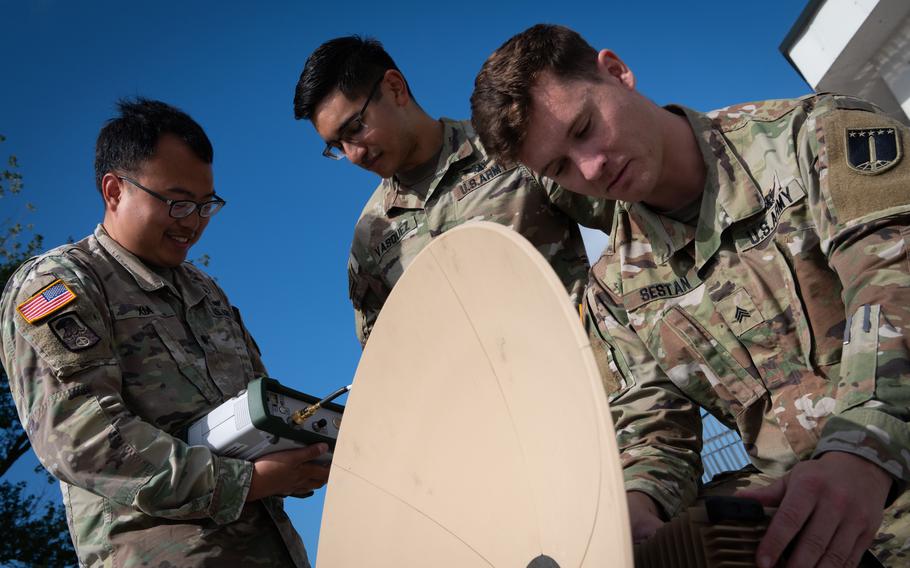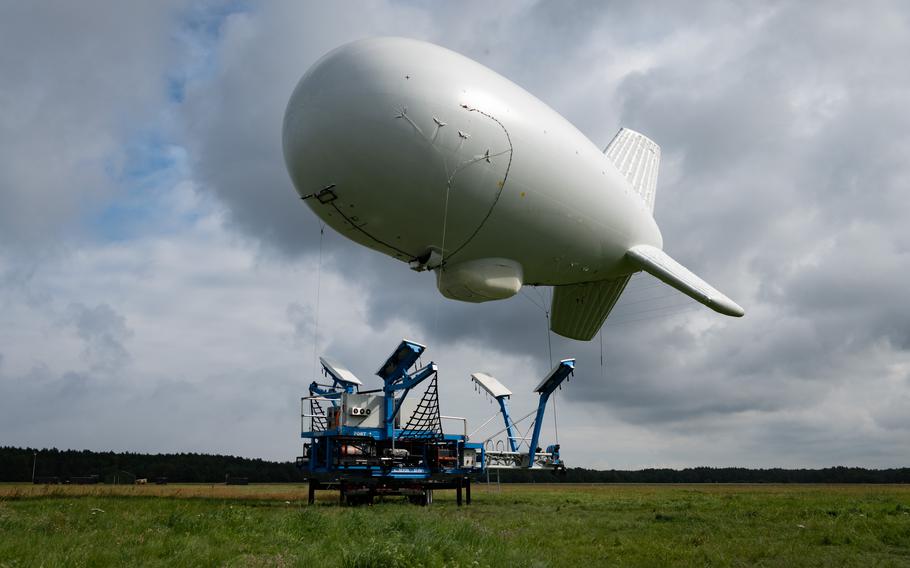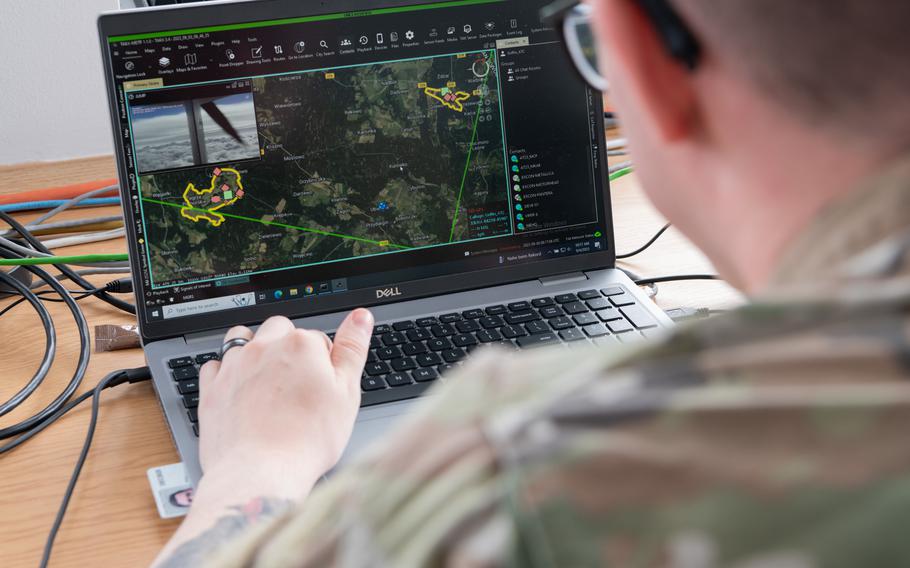
From right, Army Sgt. Justin Sestan, Staff Sgt. Karlos Vasquez and Spc. Jason Xia work with a satellite and monitoring device during exercise Arcane Thunder in Ustka, Poland, on Sept. 4, 2023. (Phillip Walter Wellman/Stars and Stripes)
USTKA, Poland — Human-sized drones and a giant observation balloon took to the skies of northern Poland this week as a unit at the forefront of the Army’s modernization process held its first major reconnaissance exercise.
Arcane Thunder is focused on using technology on earth and in space — while stopping an enemy from using theirs — and coordinating electronic means with conventional battlefield attacks.
The drills were scheduled to end Friday and involved soldiers from several Army units and partner countries. The 2nd Multi-Domain Task Force, which is running Arcane Thunder, was activated two years ago and is headquartered in Wiesbaden, Germany.
The task force is “taking things from the cyber world, from the space world, from the electronic warfare world and trying to figure out how to fuse all that stuff together,” said Lt. Col. Aaron Ritzema, commander of the 2nd Multi-Domain Effects Battalion.
“No one has ever done this on this scale and across all these different platforms,” he said.

An autonomous aerostat is used during exercise Arcane Thunder, organized by the U.S. Army's 2nd Multi-Domain Task Force, in Ustka, Poland, on Sept. 4, 2023. (Phillip Walter Wellman/Stars and Stripes)
The 2nd Multi-Domain Task Force is one of three such units, which the Army deems vital to battlefield success as it focuses on competition with larger and sophisticated forces, such as Russia and China.
The units are designed to allow the Army to synchronize electronic warfare, intelligence and cyber elements with long-range, precision artillery fire.
Inside the Arcane Thunder command post, soldiers search the electromagnetic spectrum for signals in an effort to pinpoint enemy targets. In another corner, members of the battalion’s space company monitor satellites.
“The speed of data drives everything at this point,” battalion operations officer Maj. Joe Mueller said. “If you are able to pass data quickly, you are able to make decisions quickly and you are able to have that edge and stay ahead.”
Task force members have been experimenting with new and existing technologies, and new ways to merge these technologies, as they determine what best supports their nascent mission.
Many specifics of the exercise were classified or restricted for security reasons. Photography also was prohibited throughout much of the command post.
The 2nd Multi-Domain Task Force hopes eventually to get day-to-day operations at its headquarters to mirror the activity seen over the last two weeks in Poland, Ritzema said.

A soldier supporting the Army’s 2nd Multi-Domain Task Force monitors a drone flight Sept. 4, 2023, during exercise Arcane Thunder in Ustka, Poland. (Phillip Walter Wellman/Stars and Stripes)
For now, the task force remains in its “initial build phase,” as Ritzema described it. It still doesn’t have a long-range fires battalion, a critical artillery component of the unit.
Both of the Army’s other multi-domain task forces focus on the Pacific region. One is headquartered at Joint Base Lewis-McChord in Washington state and the other in Hawaii.
The service has plans for two more of the task forces, one of which will be globally responsive. The other is expected to focus on the Arctic.
Europe was chosen as the site of the 2nd Multi-Domain Task Force in part to counter Russia on the Continent. Moscow began its full-scale invasion of Ukraine about five months after the unit’s activation in September 2021.
“I think there is a sense of urgency for us to figure out how we can contribute,” Ritzema said, when asked about the task force’s role in Europe. “And I think the current crisis gives us some additional context and information that we can use to really figure out how specifically we would want to do things.”
Arcane Thunder is being held about 130 miles from the Russian exclave of Kaliningrad, but Ritzema said it was not a specific response to any Russian action. Portions of the exercise were held in other locations in Poland, Romania and Germany.
“With current and emerging requirements in Europe, being the only multi-domain task force here is incredibly important,” said Chief Warrant Officer 4 Nick Esser, an electromagnetic warfare technician. “This is huge for this theater.”
.jpg/alternates/LANDSCAPE_910/POLAND_8885_1%201.jpg)
The main command post for the Arcane Thunder training exercise, organized by the Army’s 2nd Multi-Domain Task Force, in Ustka, Poland, Sept. 4, 2023. (Phillip Walter Wellman/Stars and Stripes)